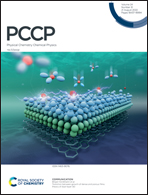The role of halogen bonds in the catalytic mechanism of the iso-Nazarov cyclization reaction: a DFT study†
Abstract
With the continuous development of halogen bonds, halogen bond donors have been used as clean and efficient catalysts in organic reactions. In this work, with inorganic halides (I2, IBr, ICl, and ICl3) as catalysts and the iso-Nazarov cyclization as the benchmark reaction, we aim at investigating the role of the halogen bond in the catalytic mechanism. The halogen bond catalyzed iso-Nazarov cyclization reaction involves three steps: carbon–carbon coupling process, [1,2]-H shift process, and [1,4]-H shift process. The halogen-bonding interaction promotes the charge accumulation of the oxygen atom in the carbonyl group and decreases the activation energy of the reaction. The catalytic activity of the halogen bond donor is enhanced in the order of I2 < IBr < ICl < ICl3, and it could be predicted that the partial covalent interaction of the I⋯O halogen bond between the catalyst ICl3 and the oxygen atom of the reactant may exhibit good catalytic activity in the experiments. In the [1,4]-H shift process, the two-step hydrogen bond/halogen bond co-catalyzed mechanism exhibits the lowest reaction energy barrier than the one-step water co-catalyzed proton transfer mechanism and the direct one.



 Please wait while we load your content...
Please wait while we load your content...